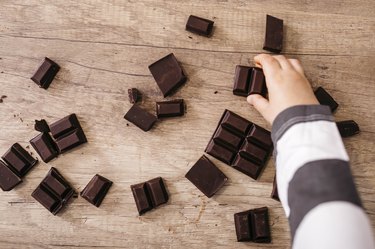
Here's some good news for chocolate lovers: the iron in milk chocolate and dark chocolate may have a positive impact on your anemia. If you struggle to get enough iron in your diet, chocolate is one food you can add — in moderation — that can have a positive impact on your iron levels.
Iron Deficiency Anemia
Video of the Day
According to the U.S. Department of Health and Human Services, iron deficiency anemia is the most common form of anemia. Anemia occurs when your body does not produce enough healthy red blood cells. Or it could occur if the red blood cells do not work properly. Iron deficiency anemia occurs when your body does not get enough iron, which plays a part making hemoglobin. Hemoglobin is a part of a red blood cell responsible for carrying oxygen to different parts of the body.
Video of the Day
Iron deficiency anemia affects more women than men due to gender specific conditions such as pregnancy and heavy menstrual cycles. However, men can experience iron deficient anemia as well. Teens, small children and infants are also at risk for developing iron deficiency anemia. Other common causes are internal bleeding and not getting enough iron in your diet.
Some common symptoms of iron deficiency anemia include:
feeling weak
dizziness
headaches
tire out quickly
grumpy or cranky
difficulty concentrating
pale skin
shortness of breath
Chocolate and Iron Deficiency Anemia
Chocolate is one of several foods that naturally contain higher levels of iron. For some people, increasing iron intake throughout the day may be enough to help prevent iron deficiency anemia. For others, such as pregnant people, people with certain conditions, and infants need to supplement their daily supply.
According to the USDA, 100 grams of milk chocolate contains 2.35mg of iron. The U.S. Department of Health and Human Services identifies that men between the ages of 19 and 50 need 8 milligrams daily and women need 18. That amounts to 30 percent of daily iron needs for a man. For women, it is still about 13 percent of daily needs.
And, if you consume a full cup of milk chocolate chips, according to the USDA, you'd consume 3.95 milligrams of iron. For men, that would be almost half of their daily needs. For women, it would be about 22 percent of their daily needs.
These numbers improve even more with dark chocolate iron levels. According to the USDA, if you consume 100 grams of 60 percent dark chocolate, you will get 3.6 milligrams of iron. For men, this would give them about 45 percent of their daily iron needs. For women, it would provide about 20 percent of their daily needs. If you eat dark chocolate with 90 percent cocoa you will get nearly 11 milligrams of iron, which is more than an average man needs and about 60 percent of what a woman needs.
Read more: Is dark chocolate healthier than milk chocolate?
Other Iron-Rich Foods
It is important to keep in mind that you should get your iron from a variety of sources. Though chocolate is certainly tempting, it also contains added refined sugars and fats that are not great for you. You should eat chocolate in moderation and as part of a well-balanced diet.
In addition to chocolate, here is a short iron food list to consider:
- red meats
- green leafy vegetables such as broccoli and spinach
- liver
- nuts
- lima and other beans
- seafood
- whole grains
- iron fortified foods such as cereal and breads
- infant formula
- dried fruits
While some fruits can contain iron, drying fruit is the best way to get iron rich fruits in your diet. For a double dose of iron, try a dark chocolate dipped dry fruit. Just remember to eat them in moderation.
Finally, if you suspect you have anemia, talk to your doctor about recommended treatment options. The iron found in food may not be enough and you may need to take additional supplements. You should follow all dietary guidelines your doctor provides you to treat your condition and prevent further health issues.
Read more: Side Effects of Intravenous Iron and Iron Overload
- US Department of Health and Human Services: "Iron-Deficiency Anemia"
- US Department of Health and Human Services: "Iron"
- U.S. Department of Agriculture: "Candies, Milk Chocolate"
- U.S. Department of Agriculture: "Dark Chocolate"
- American Academy of Family Physicians: "What is Anemia?"
- Michigan Medicine: "Iron Deficiency Anemia"
Was this article helpful?
150 Characters Max
0/150
Thank you for sharing!
Thank you for your feedback!